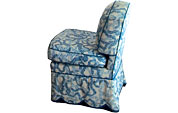
Photographs by Derry Moore
One morning late last month, the 71-year-old decorator Mario Buatta sat in the audience at a lecture given by a Domino editor. He listened as she chronicled the rise, fall, and resurgence of chintz, the floral fabric with which Buatta is closely identified. (He has been referred to, both affectionately and derisively, as “the prince of chintz” ever since TV reporter Chauncey Howell gave him the sobriquet in 1984 after seeing a show-house bedroom Buatta had festooned with the stuff.) Listening to the editor talk, Buatta was perplexed. “I thought, What is she talking about, chintz coming back?” he says. “I didn’t know it had gone anywhere.”
Although his bafflement is something of a pose, it nevertheless provides context: Buatta has been upholstering armchairs and ottomans in undulating peonies and cabbage roses for people with surnames like Cushing, Pratt, and Newhouse since he started his firm in 1963. His taste for the fabric—and English traditional décor in general—dates from childhood, when, in a classic scenario, he longed for timeworn settees and needlepoint rugs while growing up in his parents’ very modern, very clutter-free Staten Island home. “Everything was contemporary. For them, anything old was just secondhand,” he says.
But Buatta, whether he admits it or not, has seen his share of pendulum swings. He endured the mod sixties and the mirror-and-velvet seventies. Then he hit his glory years during the Reagan era, when an unprecedented amount of cash flowed into the city, and once-fusty trappings—the bows, ruffles, and tufted love seats of Buatta’s trade—were co-opted by women in taffeta Lacroix bubble skirts with block-long Park Avenue apartments to fill. They were members of nouvelle society who courted the press through lavish parties and found Buatta’s way with English traditionalism perfect. “New money was pouring in, many of those people wanted an old-money look, and Mario was there,” says Architectural Digest editor-in-chief Paige Rense.
By the early nineties, Buatta had attained a level of fame unheard-of for a decorator. Before HGTV and Design Star, Buatta was a household name: His charity show-house rooms were published in House & Garden and House Beautiful, and he appeared on the cover of now-defunct business mag Manhattan, Inc. wearing a chintz suit. He parlayed his name recognition into licenses for lamps, furniture, teddy bears, and potpourri.
“He was the eighties’ alpha decorator,” says Rense. “People had been afraid of decorators, but Mario was warm and democratic—he teases billionaires—so his clients felt comfortable.”
Underlying that personality is a talent Rense says infuses English tradition with an American sensibility: “His antecedents are the great English classicists Colefax and Fowler,” the British design firm, founded in the thirties, that epitomized blue-blood décor. But Buatta makes that heritage casual and livable. “People used to put tape on their coffee tables for the housekeeper, to mark where the books should go after dusting,” she says. “Mario got rid of the tape.” He is also deft with color. “His palette is the crux of it. Everything blends,” says Rense.
Today, in a climate in which eclectic is the design fixation of the day and a form-follows-function ethos is applied to vacuum cleaners and teapots, Buatta’s body of work, with its tassels, trims, and dog portraits, can seem anachronistic. But some 44 years after setting up shop, Buatta is still busy six or seven days a week, with clients like Mariah Carey calling his cell phone (he has no assistant and keeps his calendar on a sheet of legal paper that he updates each Sunday night). Sometimes, the pendulum doesn’t matter.
Profession: Interior DesignerPeak: 1980 to 1995Essential Design

Uptown, Now: A detailed view of the Park Avenue apartment Buatta recently completed for a socialite, showing the designer”s signature use of chintz. Photograph by Derry Moore